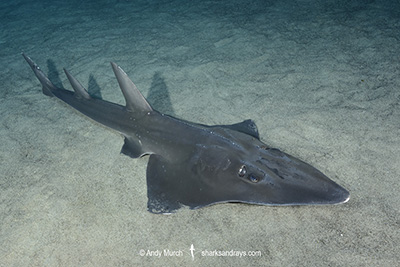Common name(s)
Whitespotted Wedgefish, Giant Guitarfish.
Identification
A large wedgefish with an acutely pointed, somewhat ‘bottle-shaped’ snout. Snout length 3.6-4.7 x orbit length. Spiracles with 2 short, equally-sized skin-folds. Anterior margins of disc almost straight or weakly undulate. Pectoral apices bluntly angular, posterior margins straight. Prominent thorns present in a continuous row along midline, and around eyes and above spiracles. Two thorn rows on each shoulder; upper row broken into two sections, lower row very short. Sometimes with a small thorn patch on cheek.
Dorsal fins tall and falcate in adults. First dorsal fin slightly larger than second, origin anterior to pelvic fin insertion. Caudal fin large with a deeply concave posterior margin and well-defined lower lobe. Lateral keel present along posterior flank to caudal base.
Colour
Dorsum dark grey to yellowish-brown, with many small white spots or rings along flanks from ocelli level to tail. Spots form 4-5 rows along flanks; more noticeable in juveniles. Prominent, spiracle-sized of larger, dark ocelli often present on flank above pectoral fin. Dusky/dark mask often present across eyes. All markings may be indistinct or absent. Ventrum white, often with small dark spots near tip of snout.
Size
Maximum length 310cm. Size at birth ~60cm.
Habitat
Tropical/subtropical seas. Demersal on soft substrates sometimes adjacent to coral reefs. From close inshore to 70m.
Distribution
Indian Ocean. Occurs from South Africa to Oman and the Arabian Gulf. The presence of giant guitarfish further east has not been determined due to confusion identifying closely related species of wedgefishes.
Conservation Status
CRITICALLY ENDANGERED
The ‘white’ fins of shark-like rays (including sawfishes, wedgefishes, and giant guitarfishes) are considered the best quality fins for human consumption and are among the highest valued in the international shark fin trade. The meat is of high quality and generally consumed locally. There is a high level of fisheries resource use and increasing fishing pressure across the range of the Whitespotted Wedgefish, and as a result, targeted and incidental fishing effort is placing significant pressure on all wedgefish species in the Indo-West Pacific. Where wedgefishes and giant guitarfishes have been targeted or exploited as incidental catch, severe declines, population depletions, and localized disappearances have occurred. Severe population reduction in the Whitespotted Wedgefish is inferred from actual levels of exploitation, as well as several historical accounts and contemporary datasets from Iran, Pakistan, India, Thailand, and Indonesia (and while most of these datasets are outside the range of the Whitespotted Wedgefish, they can be considered representative of population reduction throughout the Indo-West Pacific). While similar data are not available for the range of the Whitespotted Wedgefish (with the exception of the Iran dataset which shows a 91% population reduction over the last three generations), actual levels of exploitation are high across the range of this species with the exception of South Africa, and there is nothing to suspect that similar declines have not occurred in the Western Indian Ocean. The Whitespotted Wedgefish has been targeted in East Africa, and there is anecdotal reports suggesting population reduction in countries such as Mozambique, Tanzania, and Madagascar. In South Africa, there has been a marked decline in the catch-per-unit-effort of Whitespotted Wedgefish in shark bather protection nets in KwaZulu Natal. However, this decline may not be a good indicator of abundance, as it may be explained, at least partially, by a shift in gear deployment whereby nets were gradually lifted off the substrate. Fishing pressure is less intensive in South Africa than elsewhere, but this country represents the southern extent of the species’ range and only a small proportion of its distribution. Overall, it is inferred that the Whitespotted Wedgefish has undergone a >80% population reduction over the last three generations (45 years) and it is assessed as Critically Endangered A2bd.
Citation
Kyne, P.M., Gledhill, K. & Jabado, R.W. 2019. Rhynchobatus djiddensis. The IUCN Red List of Threatened Species 2019: e.T39394A121035795. https://dx.doi.org/10.2305/IUCN.UK.2019-2.RLTS.T39394A121035795.en. Downloaded on 13 May 2021.
Reproduction
Aplacental lecithotrophic viviparous. Litter size ~4.
Diet
Feeds mainly on demersal fishes, crabs, and bivalves.
Behavior
Migratory. Tagged whitespotted wedgefishes from in KwaZulu-Natal, South Africa were largely absent in the winter, presumably moving north.
Reaction to divers
Difficult to approach.
Diving logistics
Due to overfishing, the whitespotted wedgefish is rarely encountered along much of the east coast of Africa but it still quite common in South Africa. Sightings occur at dive sites in Sodwana Bay, and beach fishermen frequently catch this species in Zululand and Kwa Zulu Natal, so dive sites all along that coastline could be productive during the summer months.
What’s new
View our full list of updates
Similar species
Bottlenose Wedgefish Distinguishable by more bottlenosed snout, lack of dusky mask across eyes, and less spots.
Smoothnose Wedgefish Distinguishable by straight anterior margins of disc.


